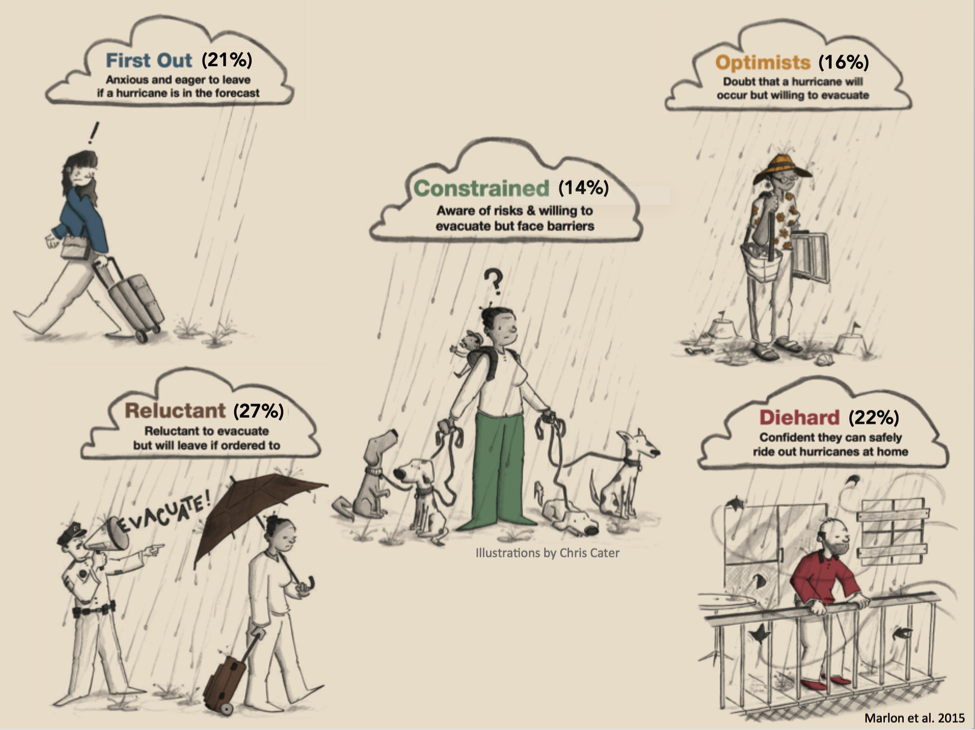Blog · August 30, 2017
Can accurate forecasts alone keep the public safe in hurricanes? Lessons from Superstorm Sandy
By Jennifer Marlon and Eric Fine
In 2014, after Superstorm Sandy, we conducted a study of coastal Connecticut residents and found that many people lack basic awareness and understanding of hurricane risks. These results are likely similar to many other communities along America’s vulnerable coastlines. Among our key findings were:
- 70% of coastal residents were either unsure or unaware that their home is in an evacuation zone
- 74% of coastal residents had never seen an evacuation map
- 21% said they would evacuate for a Category 2 hurricane if they did NOT receive an official notice
- 34% of coastal residents believe it would be safer to stay at home during a Category 2 hurricane
An additional study, Hurricane Attitudes of Coastal Connecticut Residents: A Segmentation Analysis examined why some people decide to evacuate, while others try to ride out the storm.
We found five distinct groups: the “First Out” (21% of the population); the “Constrained” (14%); the “Optimists” (16%); the “Reluctant” (27%); and the “Diehards (22%).” The First Out are the most likely to evacuate during a hurricane whereas the Diehards are the least likely to leave. Each group, however, has unique characteristics.
Different groups will interpret storm risks and messages through different lenses. As a result, even if a perfectly accurate forecast is made and communications are clear and coordinated, people are going to respond in diverse ways. Many individuals will rely heavily if not exclusively on official advisories, so clear and consistent evacuation orders are particularly important. Evacuation information needs to be delivered by a variety of trusted sources, including local police or firefighters, and the more personalized the delivery, the better. In other cases, individuals may also need to know that their lives are truly at risk, their homes will be unsafe if they remain, and that by staying they are also putting emergency responders at risk.
In all cases, clear and simple messages, repeated often, by a variety of trusted sources is critical to effective public messaging. Likewise, vivid, concrete messages are better than abstract ones; telling people “your toilet won’t work” is likely more effective than saying “services will be disrupted”; explaining that the police chief (typically a trusted authority figure) is evacuating his own family right now, may be more persuasive than showing abstract weather forecast maps. Role modeling preparedness and evacuation behavior can be more powerful than abstract advisories.
NOTE: This research was funded by NOAA under the Coastal Storm Awareness Program (NOAA awards NA13OAR4830227, NA13OAR4830228, NA13OAR4830229) from the National Sea Grant College Program, National Oceanic and Atmospheric Administration, U.S. Department of Commerce.
For further reading:
Carr, R. H., Montz, B., Semmens, K., Maxfield, K., Hoekstra, S., & Goldman, E. (2016). Motivating action under uncertain conditions: Enhancing emergency briefings during coastal storms. Weather, Climate, and Society, 8(4), 421-434.
Rickard, L. N., Schuldt, J. P., Eosco, G. M., Scherer, C. W., & Daziano, R. A. (2017). The proof is in the picture: The influence of imagery and experience in perceptions of hurricane messaging. Weather, Climate, and Society, 9(3), 471-485.
Rickard, L. N., Yang, Z. J., Schuldt, J. P., Eosco, G. M., Scherer, C. W., & Daziano, R. A. (2017). Sizing up a superstorm: exploring the role of recalled experience and attribution of responsibility in judgments of future hurricane risk. Risk analysis.
